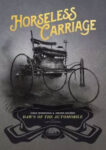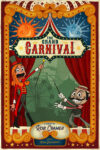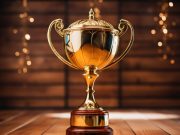It’s an old proverb, “How many ways are there to skin a cat?” As a cat owner myself, I can confidently say zero and apologize to other cat lovers. However, when it comes to board games, we can easily change this to “How many ways are there to make polyominoes an interesting board game puzzle?” Designers, it seems, love to answer this question. But not all answers are good answers. The Board Game Quest brick-laying guild has decided to vet these answers and offer some experienced takes on a few of their faves. Read on to see if you agree or if you find that these opinions don’t stack up!
The Best Polyomino Board Games
Horseless Carriage
Chosen by Dylan:
 Horseless Carriage isn’t what you would usually think of when you think of a polyomino game. It has player interaction. It balances the tile placement with economic selling of your cars. It has all those factors but still stands out. Where you place your tiles is so critical. You may place a break tile to add to your cars and feel good about it. But two rounds later, you are thinking “Why did I place those brakes there? They’re right in the way of what I want to add next” The game is more than likely the most complex game on the list. In both of my in-person plays, we had to use a second table to fit everything (and before you ask if I am recommending it based on two plays, I’ve gotten in some plays online too). The game makes you think in a really cool way and is a different experience than one would expect from the genre.
Horseless Carriage isn’t what you would usually think of when you think of a polyomino game. It has player interaction. It balances the tile placement with economic selling of your cars. It has all those factors but still stands out. Where you place your tiles is so critical. You may place a break tile to add to your cars and feel good about it. But two rounds later, you are thinking “Why did I place those brakes there? They’re right in the way of what I want to add next” The game is more than likely the most complex game on the list. In both of my in-person plays, we had to use a second table to fit everything (and before you ask if I am recommending it based on two plays, I’ve gotten in some plays online too). The game makes you think in a really cool way and is a different experience than one would expect from the genre.
3-5 Players • Ages 14+ • 180 minutes • $90
Foundations of Rome
Chosen by Tony:
 I may be cheating a little by choosing Foundations of Rome, as it’s probably not as steeped in polynomials as other games on this list. But it has squares, rectangles, and even some 90-degree turn pieces, so I’m counting it. Shapes aside, Foundations of Rome is in my Top 5 board games ever list, so of course I had to choose this one. From its silky-smooth gameplay to its amazing production values, this board game lets you watch the city of Rome come to life before your eyes. Sure, it’s ridiculously overproduced, but that’s part of its charm in my book. The recently released Foundations of Metropolis seeks to make a more cost-effective version of the game, but this is the only version I need to own. I also want to give a shout out to Planet Unknown, which was my runner-up pick. If I had to choose one that used polyominoes a bit deeper, this one would be it.
I may be cheating a little by choosing Foundations of Rome, as it’s probably not as steeped in polynomials as other games on this list. But it has squares, rectangles, and even some 90-degree turn pieces, so I’m counting it. Shapes aside, Foundations of Rome is in my Top 5 board games ever list, so of course I had to choose this one. From its silky-smooth gameplay to its amazing production values, this board game lets you watch the city of Rome come to life before your eyes. Sure, it’s ridiculously overproduced, but that’s part of its charm in my book. The recently released Foundations of Metropolis seeks to make a more cost-effective version of the game, but this is the only version I need to own. I also want to give a shout out to Planet Unknown, which was my runner-up pick. If I had to choose one that used polyominoes a bit deeper, this one would be it.
2-4 Players • Ages 10+ • 60-90 minutes • $220
Patchwork
Chosen by Jacob:
 When we think of polyominoes, we can’t help but also think of Uwe Rosenberg. The two are essentially synonymous. Rosenberg is responsible for many of the best, including modern classics such as A Feast for Odin, his garden series (Cottage Garden, Indian Summer, and Spring Meadow), more recent entries such as New York Zoo, and of course the GOAT, Patchwork. Why is Patchwork his best? Well, it’s not his best game, but it’s absolutely his most focused use of the polyomino component. Purchase a tile and add it to your quilt. Collect your buttons. Move forward in time. The words themselves sound utterly bucolic, and while experienced gamers can certainly get a bit cutthroat in this game, the theme always keeps players grounded. You’re making a damn quilt, ok? Chill. It’s the perfect compact couples’ game to take with you on your vacations or on a trip to a brewpub or cafe and it also happens to be one of the greatest “gateway” games out there. It’s my first suggestion when non-gamers ask me for a request for a good 2-player game. Wrap yourself in its warmth.
When we think of polyominoes, we can’t help but also think of Uwe Rosenberg. The two are essentially synonymous. Rosenberg is responsible for many of the best, including modern classics such as A Feast for Odin, his garden series (Cottage Garden, Indian Summer, and Spring Meadow), more recent entries such as New York Zoo, and of course the GOAT, Patchwork. Why is Patchwork his best? Well, it’s not his best game, but it’s absolutely his most focused use of the polyomino component. Purchase a tile and add it to your quilt. Collect your buttons. Move forward in time. The words themselves sound utterly bucolic, and while experienced gamers can certainly get a bit cutthroat in this game, the theme always keeps players grounded. You’re making a damn quilt, ok? Chill. It’s the perfect compact couples’ game to take with you on your vacations or on a trip to a brewpub or cafe and it also happens to be one of the greatest “gateway” games out there. It’s my first suggestion when non-gamers ask me for a request for a good 2-player game. Wrap yourself in its warmth.
2 Players • Ages 8+ • 30 minutes • $32
A Feast for Odin
Chosen by Tahsin:
 There’s a big reason Uwe Rosenberg has at least two games on this list. When he designed Patchwork, it was like a minor essay on the mechanism of polyomino placement. A gentle introduction for two players for a space he really wanted to explore. A Feast for Odin is his grand opus that marries two of his favorite mechanisms: worker placement and polyomino puzzling. The worker placement side of the game is a masterful companion element to the puzzle space since players are not only placing workers in certain spaces to gain pieces to place on their puzzle, but also trying to upgrade to higher value pieces and gain just the right segments to (you knew it was coming) provide food for their workers. The polyomino puzzle is not just a “complete the entire space” kind of challenge, it also ties into the player’s game resource income. Players are offered as many boards as they can fill to score as many points as they are able (empty spaces are negative points). It’s a little steep to learn all the ins and outs at first, but it’s highly addictive. A completed game immediately invites introspection about what to do better next time. As such, it’s an easy choice to make it onto this list.
There’s a big reason Uwe Rosenberg has at least two games on this list. When he designed Patchwork, it was like a minor essay on the mechanism of polyomino placement. A gentle introduction for two players for a space he really wanted to explore. A Feast for Odin is his grand opus that marries two of his favorite mechanisms: worker placement and polyomino puzzling. The worker placement side of the game is a masterful companion element to the puzzle space since players are not only placing workers in certain spaces to gain pieces to place on their puzzle, but also trying to upgrade to higher value pieces and gain just the right segments to (you knew it was coming) provide food for their workers. The polyomino puzzle is not just a “complete the entire space” kind of challenge, it also ties into the player’s game resource income. Players are offered as many boards as they can fill to score as many points as they are able (empty spaces are negative points). It’s a little steep to learn all the ins and outs at first, but it’s highly addictive. A completed game immediately invites introspection about what to do better next time. As such, it’s an easy choice to make it onto this list.
1-4 Players • Ages 12+ • 30-120 minutes • $75
Isle of Cats
Chosen by Emma:
 So there are these cats, right? They’re magic, and they’re living happily as can be on an island all to themselves. But then evil pirates make an evil plot to kidnap them! You live nearby and get wind of this plan and decide to save the cats by smuggling them to the mainland. But what, exactly, is the most efficient way to shove as many as possible of these strangely boxy cats onto your ship? Thank God you’re good at Tetris! My favorite thing about Isle of Cats, besides the bonkers storytelling, is that it works for a lot of different types of players. There’s a family mode that simplifies the rules to the bare minimum of placing cat shaped polyominos on a ship board, the regular mode which introduces special abilities for the cats and island exploration, and there are multiple game expansions which each add new rules and complications. Scoring is satisfying at each level of complexity, rewarding thoughtful placement and careful planning. Isle of Cats is a good time for any tile placement fans, and a purrrfect choice for families.
So there are these cats, right? They’re magic, and they’re living happily as can be on an island all to themselves. But then evil pirates make an evil plot to kidnap them! You live nearby and get wind of this plan and decide to save the cats by smuggling them to the mainland. But what, exactly, is the most efficient way to shove as many as possible of these strangely boxy cats onto your ship? Thank God you’re good at Tetris! My favorite thing about Isle of Cats, besides the bonkers storytelling, is that it works for a lot of different types of players. There’s a family mode that simplifies the rules to the bare minimum of placing cat shaped polyominos on a ship board, the regular mode which introduces special abilities for the cats and island exploration, and there are multiple game expansions which each add new rules and complications. Scoring is satisfying at each level of complexity, rewarding thoughtful placement and careful planning. Isle of Cats is a good time for any tile placement fans, and a purrrfect choice for families.
1-4 Players • Ages 8+ • 60 minutes • $45
The Grand Carnival
Chosen by James:
 “Step right up to the Grand Carnival!” This crowdfunded game from Rob Cramer and illustrated by Ryan Goldsberry transports you to the Summer of 1937 when the carnival came into town. You’re trying to build the greatest show on earth which requires adding foundations (square tiles with mallets representing areas you can build) and then attractions (the polyominos) to your player boards. You also have patrons visiting your attractions and barkers to encourage them to get to the Big Top at the top of your player board. But don’t forget to leave space for walking paths or some attractions will never score. While only slightly deeper than Barenpark (which is my runner up), Grand Carnival has a lot more depth and that’s without adding in the expansions which give different city goals, enormous attractions, and more which also give it a lot of replay value. Add in the fun art and player tokens (Strongman, Sea lion balancing a ball on its nose, rabbit coming out of a top hat, etc.) and it’s a joy to look at on the table and, like all the games on this list, makes you feel like you built something by the end of the game.
“Step right up to the Grand Carnival!” This crowdfunded game from Rob Cramer and illustrated by Ryan Goldsberry transports you to the Summer of 1937 when the carnival came into town. You’re trying to build the greatest show on earth which requires adding foundations (square tiles with mallets representing areas you can build) and then attractions (the polyominos) to your player boards. You also have patrons visiting your attractions and barkers to encourage them to get to the Big Top at the top of your player board. But don’t forget to leave space for walking paths or some attractions will never score. While only slightly deeper than Barenpark (which is my runner up), Grand Carnival has a lot more depth and that’s without adding in the expansions which give different city goals, enormous attractions, and more which also give it a lot of replay value. Add in the fun art and player tokens (Strongman, Sea lion balancing a ball on its nose, rabbit coming out of a top hat, etc.) and it’s a joy to look at on the table and, like all the games on this list, makes you feel like you built something by the end of the game.
1-4 Players • Ages 12+ • 45-60 minutes • $48
My City
Chosen by April:
 Midway through a campaign of My City on boardgamearena.com, I was so excited about it that I bought my own copy to play with my family. It’s not the sort of campaign you play for the immersive story, but it is a fun and dynamic take on tile placement, spicing things up with small twists just when you start to feel comfortable. I’m a gamer who doesn’t like to know what’s coming, so I find the challenge of working with the shapes drawn to be immensely satisfying. Most scoring has to do with grouping colors or placing your polyominoes next to specific features and, for me, working out the puzzle as you go is pure joy. This one won’t be for everyone, particularly those after a more thematic experience (it’s Knizia, after all), but I’ll happily play it any day- which is possible since the game can continue to be played even after finishing the campaign.
Midway through a campaign of My City on boardgamearena.com, I was so excited about it that I bought my own copy to play with my family. It’s not the sort of campaign you play for the immersive story, but it is a fun and dynamic take on tile placement, spicing things up with small twists just when you start to feel comfortable. I’m a gamer who doesn’t like to know what’s coming, so I find the challenge of working with the shapes drawn to be immensely satisfying. Most scoring has to do with grouping colors or placing your polyominoes next to specific features and, for me, working out the puzzle as you go is pure joy. This one won’t be for everyone, particularly those after a more thematic experience (it’s Knizia, after all), but I’ll happily play it any day- which is possible since the game can continue to be played even after finishing the campaign.
2-4 Players • Ages 10+ • 30 minutes • $25
Cartographers
Chosen by Alex:
 Well, everyone knows polyomino games require tiles to be placed, but my theory presupposes that you can also draw in polyomino shapes on a grid and have yourself a polyomino game. While many worthy titles take this model and apply it in a variety of ways, there is no exemplar more superior than Cartographers. Tas introduced it to me at a PAXU or three ago, and I immediately fell in love with it. There’s a ton of game in a small box, with plenty of choices in the best way to map out your kingdom. Do you sketch in the bigger terrain tiles in the hopes of getting more points via goals, or do you take the smaller tiles with the goal of building up your treasury? Which scoring goal to you try and go after with your choice of terrain? Can you leave the empty space in such a way that monsters cannot invade? Even in with just the base game, there is plenty to keep your interest, and if you’re like me and you play with colored pencils nearby, you end up not only with a good time at the game table, but some pretty art as well!
Well, everyone knows polyomino games require tiles to be placed, but my theory presupposes that you can also draw in polyomino shapes on a grid and have yourself a polyomino game. While many worthy titles take this model and apply it in a variety of ways, there is no exemplar more superior than Cartographers. Tas introduced it to me at a PAXU or three ago, and I immediately fell in love with it. There’s a ton of game in a small box, with plenty of choices in the best way to map out your kingdom. Do you sketch in the bigger terrain tiles in the hopes of getting more points via goals, or do you take the smaller tiles with the goal of building up your treasury? Which scoring goal to you try and go after with your choice of terrain? Can you leave the empty space in such a way that monsters cannot invade? Even in with just the base game, there is plenty to keep your interest, and if you’re like me and you play with colored pencils nearby, you end up not only with a good time at the game table, but some pretty art as well!
1+ Players • Ages 8+ • 30-45 minutes • $21





















Good list. If it was just a list of my favorites, I would probably include Planet Unknown; it is so much fun chaining a bunch of activations.
Spencer was actually going to pick Planet Unknown for his choice, but life got in the way and he didn’t have a chance to get his entry in.
I would have chosen Planet Unknown if Spencer hadn’t nabbed it first. It’s an evergreen title for us at game night.
Nice list, and I appreciate your concise synopsis for each game. I completely agree on the Planet Unknown suggestion. It’s a wonderful polyomino game. Another honorable mention for me is Art Society. The polyominos there are simply variations on a rectangle, bit it still has the puzzle-y fun of poliominos.